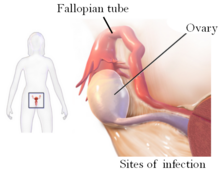Tubo-ovarian abscess

A tubo-ovarian abscess is an infection of the female ovary and fallopian tube. It is a pus-filled ovary and Fallopian tube that is filled with infection. This type of abscess is caused by an untreated sexually transmitted disease.[1][2] It can be a complication after surgery to remove the uterus.[3]: 103
When a woman has this abcess, she has a fever, signs of infection in her blood, severe pain in her pelvic area. She may also have a vaginal discharge. Many different kinds of bacteria can cause tubo-ovarian abscess. Tubo-ovarian abscess is rare in virgins.[4][5]
Symptoms and causes[change | change source]
The symptoms of tubo-ovarian abscess are the same as pelvic inflammatory disease. The abscess can be seen with x-rays and other medical equipment.[1] The bacteria that cause gonorrhea can cause tubo-ovarian abscess. The microorganism that causes a Chlamidia infection can cause tubo-ovarian abscess. Other bacteria can cause tubo-ovarian abscess[6][7] Using an IUD for a long time can cause TOA.[7]
The abcess can rupture filling the abdomen with the infection. This is an emergency and a woman can die if this ruptured abscess is not treated quickly. A blood infection can happen if the abscess is not treated.[3]: 103 Sometimes an inter uteran device, a form of birth control can cause the abcess.[1]
Prevention and treatment[change | change source]
Some things make a woman more likely to get this disease. These things are: sexual activity, increased age, IUD insertion, chlamydia infection, bacterial infection, sexually transmitted disease.[8] This disease is cured by treatment with medicine that will kill the bacteria that are causing the infection. Some doctors will use intravenous antibiotics for least 24 hours. Some women with this infection have to go to the hospital. Sometimes surgery has to be done.[1][9] After being in the hospital, medicine can be taken by mouth that will continue to cure the infection.[3]: 103 Patients are checked by a doctor three days after being in the hospital. They then get another check up one to two weeks later to make sure that the infection is cured.[3]: 103
Complications[change | change source]
Sometimes this infection is complicated. In some cases the ovary and fallopian tubes have to be taken out. Without ovaries or Fallopian tubes a woman may not be able to have a baby. There are other things that can happen during surgery that result in a bad outcome. But this is true for all surgeries.
How many women are affected[change | change source]
One million women get tubo-ovarian abscess every year.[10]
References[change | change source]
- ↑ 1.0 1.1 1.2 1.3 Pelvic inflammatory disease.
- ↑ "CDC - Pelvic Inflammatory Disease - 2010 STD Treatment Guidelines". Retrieved 2015-05-16.
- ↑ 3.0 3.1 3.2 3.3 Hoffman, Barbara (2012). Williams gynecology. New York: McGraw-Hill Medical. ISBN 9780071716727.
- ↑ Goodwin, K.; Fleming, N.; Dumont, T. (2013). "Tubo-ovarian Abscess in Virginal Adolescent Females: A Case Report and Review of the Literature". Journal of Pediatric and Adolescent Gynecology. 26 (4): e99–e102. doi:10.1016/j.jpag.2013.02.004. ISSN 1083-3188. PMID 23566794.
- ↑ Ho, Jeh Wen; Angstetra, D.; Loong, R.; Fleming, T. (2014). "Tuboovarian Abscess as Primary Presentation for Imperforate Hymen". Case Reports in Obstetrics and Gynecology. 2014: 1–3. doi:10.1155/2014/142039. ISSN 2090-6684. PMC 4009186. PMID 24822139.
- ↑ Landers, D. V.; Sweet, R. L. (1983). "Tubo-ovarian Abscess: Contemporary Approach to Management". Clinical Infectious Diseases. 5 (5): 876–884. doi:10.1093/clinids/5.5.876. ISSN 1058-4838. PMID 6635426.
- ↑ 7.0 7.1 Lentz, Gretchen (2013). Comprehensive gynecology. Philadelphia: Mosby Elsevier. p. 558. ISBN 9780323069861.
- ↑ Lee, Suk Woo; Rhim, Chae Chun; Kim, Jang Heub; Lee, Sung Jong; Yoo, Sie Hyeon; Kim, Shin Young; Hwang, Young Bin; Shin, So Young; Yoon, Joo Hee (2015). "Predictive Markers of Tubo-Ovarian Abscess in Pelvic Inflammatory Disease". Gynecologic and Obstetric Investigation. 81 (2): 97–104. doi:10.1159/000381772. ISSN 0378-7346. PMID 25926103. S2CID 27186672.
- ↑ Lentz, Gretchen (2013). Comprehensive gynecology. Philadelphia: Mosby Elsevier. p. 584. ISBN 9780323069861.
- ↑ "PID Epidemiology". Center for Disease Control. Archived from the original on 2015-02-22. Retrieved 2015-05-21.
